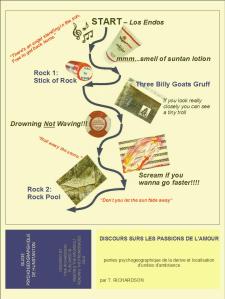By Tina Richardson
On August 4th 2010 my original plan to research the elderly mobility issue in the seaside resort of Hunstanton was aborted due to bad weather. I had been planning on taking out my father’s buggy for a test run, a sort of ‘star in a reasonably priced car’ but with no star and only something vaguely resembling a car. It rained that morning and looked like it was going to rain on and off all day. So instead I decided to do a walk around Le Strange Arms; an area in Old Hunstanton that has a hotel, pub, golf course, arts and crafts centre, beach cafe and a plethora of signs which are always of interest to the psychogeographer.
The Le Strange Family
I am not going to provide an in depth history of the Le Strange family here, as this exists in abundance elsewhere, but I would just like to situate the area historically. The Le Strange family were responsible for developing the new beach area of New Hunsatnton (now Hunstanton) in 1846. Investors were persuaded by Henry Styleman Le Strange to fund the new railway line, and Hunstanton became the first seaside resort of the railway age. There was practically nothing in what is now Hunstanton prior to this period. Le Strange built the town: he moved the old village cross to the new area, built its first hotel (what is now the Golden Lion) and Hunstanton soon became a popular resort for the Victorians. I have heard that there were 16 trains a day in 1911. The line was sadly decommissioned in 1969. There are proposals to have it reopened.
Le Strange Arms Hotel
Old Hunstanton, where the hotel is located, is a short walk from Hunstanton town centre. When you approach it from the coast road, you actually come to the back of the hotel, rather than the original front which faces the beach. This photo shows what is now the rear of the hotel, facing onto its own car park, gardens and then the coastline:
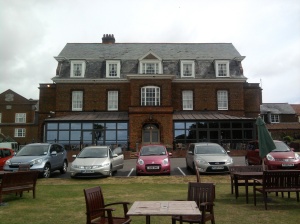
This image shows the staircase winding up the side of it on a more recently built modern section of the hotel:

The gardens were pleasant with a conservatory/sun lounge at the bottom: really nice but not modern, obviously…

…but what I did really like was this play centre for the children which I thought was almost sculpture-like:
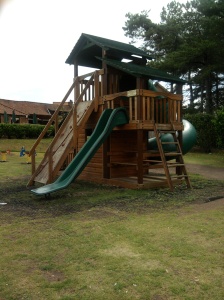
The garden just borders the coastal grass area, just prior to the sand. I managed to get a good photo of the beach huts from there:
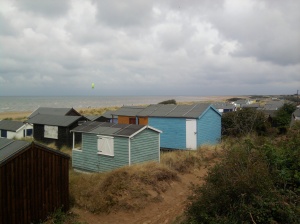
This red wall post box was on the periphery of the hotel ground:
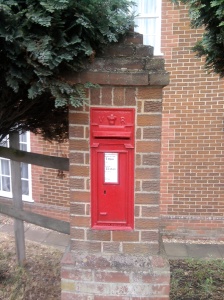
Seaside Paraphernalia and Imagery
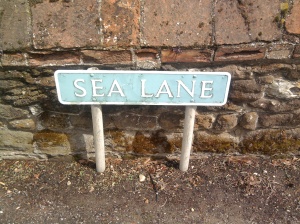
Just prior to heading down towards the beach I saw a memorial bench dedicated to John ‘Grouch’ Chapman. It seems he was a freemason, as the bench is placed by the Martin Folkes Lodge who meet in the Le Strange Arms Hotel.
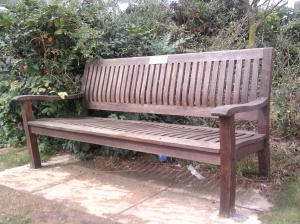

The beach car park is on the left of the path that leads down to the beach.
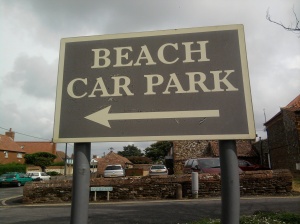
The public car park has a lovely frieze. While there are barely any people depicted (only one in a deck chair), the animals seem to be having a great time:
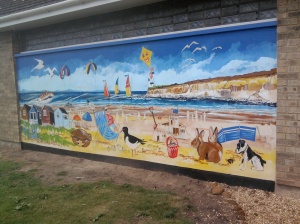
The Beach Cafe is only a few yards from the hotel. I walked down the slope and came upon two friendly people with dogs who let me take their photo – which I thought was extremely kind in these surveillance-paranoid times. The woman had a nice sunhat on and practical wellies. The dogs took a while to calm down in order for me to take the photo, they probably thought they were stopping for ice cream rather than the whims of a blogger. The owners were patient and gave me excellent seaside smiles, as you can see:

This picture was taken outside the Beach Cafe which was like an Aladdin’s cave and sold everything. I like beach paraphernalia. It is always hyper-colourful and there is something transient about it. I’m not sure if this is because of the cheap plastic of which most of it is made, or rather because summer is always fleeting, especially in Britain. I guess there is also some nostalgic childhood notion attached to it.
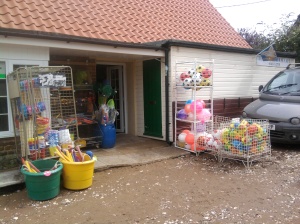
I don’t think the cafe ever sold many postcards. They were quite dusty and very old. I bought one that has a photo on it that was probably originally taken before 1978. The final section of the previously burned down pier was pulled down at that time, and it looks like the photographer was standing on the remaining section of the pier when the photo was shot. I have posted this postcard to myself at my university address. I will see if it arrives and shall include a mini blog on it later if it does.
I had a cappuccino and some ice cream at the cafe. My second ice cream of the summer.
The Royal National Lifeboat Institution
The RNLI was situated opposite the cafe:


Here is a link to the RNLI site at Hunstanton:
Hunstanton Lifeboat Station

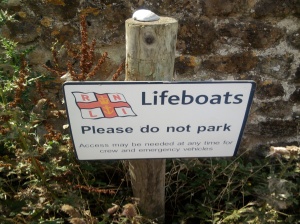
Unfortunately the ‘video’ section of the website does not have any films uploaded yet. Instead I have included a film of a Skegness/Hunstanton RNLI exercise session below. They appear to have a Christmas tree on the back of the boat. They look to be having fun and I’m thinking this may be a ‘jolly’ disguised as an exercise.
Hunstanton/Skegness RNLI Exercise
Prohibitive Signs
If I didn’t include a section on the signs that are instructing you to do and not do things, I wouldn’t be carrying out my psychogeographic duties properly. My favourite one is the first one, which was on the fence of a property.
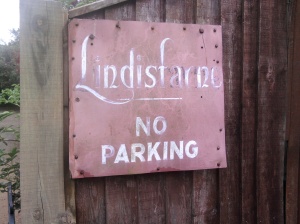
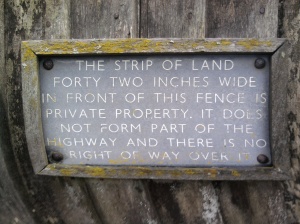
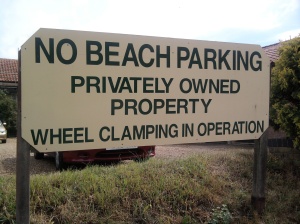

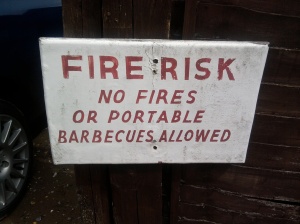
The Ancient Mariner
While the Ancient Mariner is actually a pub in Old Hunstanton it is also an epic poem by Coleridge. So I have included a couple of lines here:
The ice was here, the ice was there,
The ice was all around:
It cracked and growled, and roared and howled,
Like noises in a swound!
I chose these lines as I found out that the sea in this area was so cold that it froze in 1940. I didn’t know what a ‘swound’ was so looked it up on google. According to wikipedia they are a band from Nottingham who made up the word themselves – ooops, sorry boys, Samuel Taylor got there first! A ‘swound’ also appears to be a ‘swoon’.
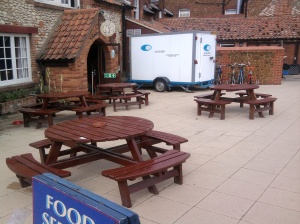

You reach the Ancient Mariner Inn before you get to Le Strange Arms Hotel. The pub faces the arts and crafts centre opposite.
Leaving the Strangeness Behind
I walked back via the lighthouse and St Edmunds arch. I didn’t take a photo of the lighthouse but a video instead, which I’ve struggled to upload. This is St Edmund’s arch, which I am showing as a taster to a possible future blog on the area which is currently under conservation:
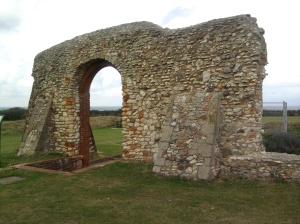
Here is a link to a great photo of the lighthouse:
Hunstanton Lighthouse
Of course, I don’t see Hunstanton as really being strange. The seaside, however, has a unique topography suggesting concepts such as liminality (it is a threshold of uncertainty and a blurred boundary between the land and sea); and historically, otherness, in the sense that the sea always had (has) the potential for bringing an unexpected other to the shores of the homeland.
For information on my other work, please go to: particulations




































